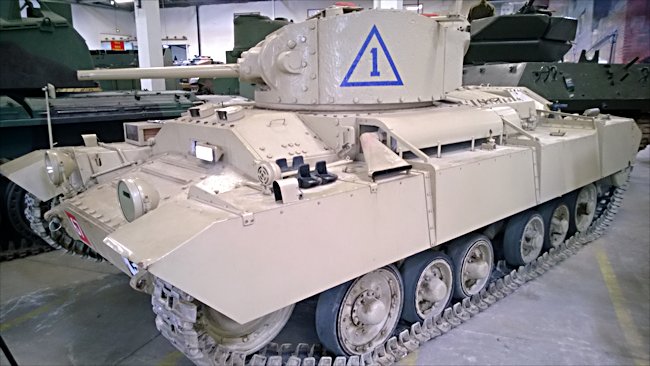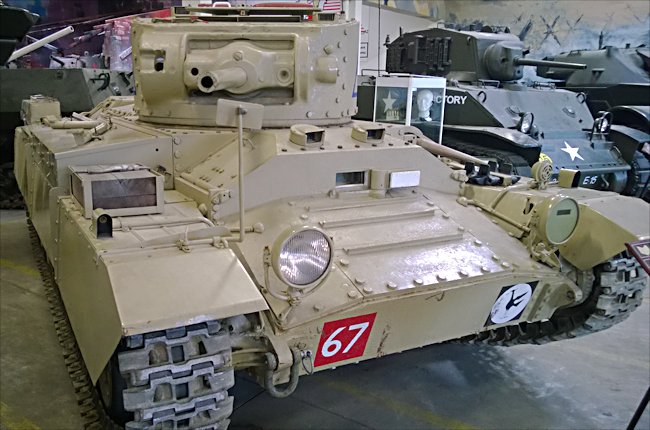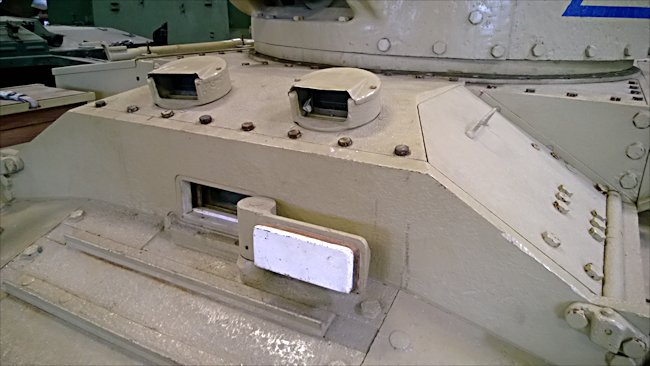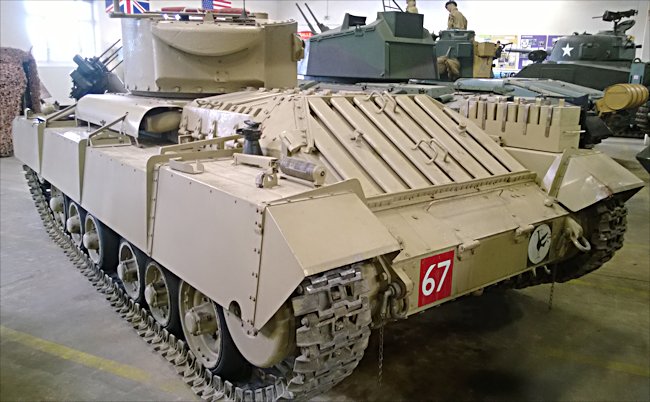The British Valentine Mk III Tank
This early WW2 British Valentine Mk III Tank can be found at the French Tank Museum in Saumur in the Loire Valley.

Valentine Mk III Tank fitted with the early Mk I turret that was designed to take a 2 pdr gun.
Location
The Museum is called Musée des Blindés ou Association des Amis du Musée des Blindés, 1043, route de Fontevraud, 49400 Saumur, France. Their website is www.museedesblindes.fr . The word Blindés means armoured. It is only a 2 hour journey by train from Paris Montparnasse Railway Station.
This Valentine Tank's Story
This infantry support tank appeared in June 1940. Around 3,700 tanks were produced. Most saw action in North Africa but some were sent to the Soviet Army. The Saumur Valentine was built as T60133 by the Birmingham Railway Factory as a Mk III bridge laying tank but by 1948 it had been converted into a bulldozer and given the post war number of 53ZR73. It was later scrapped and resided in Pounds scrapyard in Portsmouth for years.
It was then sold to someone in Kent where it was spotted in 1984. Later it was on show with a Covenanter turret in Cornwall before being restored at great expense with a Mk 1 turret from Sennybridge and an engine/gearbox recovered from Cyprus. It was then sold to the French Tank Museum in Saumur in 1996

The driver of the Valentine Mk III Tank had the use of two periscopes and a vision slit that was protected by an armoured flap.
The Valentine Tank arrives in North Africa
After the early experiences in North Africa fighting the Italians and Germans, the British Tankers knew they really needed a better tank. Lieutenant Stuart Hamilton did not have a good word to say about the recent new arrival, the low silhouette Valentine tank. It had three and a half inches of armour but was only armed with a piddling little 2pdr pop-gun as a main gun.
British 8th Army tank crews already realised it was "bloody useless" against the 50mm long-barrelled gun fitted to the German Panzer Mark III tank or the more powerful 75mm long barrelled Mark IV. In the desert the effective range of a gun was important as tanks were visible form long distances over open deserts with little natural protection.
It meant that at long range German tank crews could keep firing at approaching Valentine tanks without fear of retaliation until they got a lot closer. Even then only a lucky shot from their 2pdr gun would do any damage on their frontal armour. Most would just ricochet off.
The Mark IV panzer crews would often veil the easily identifiable long barrel silhouette by driving with it fully depressed on the front deck in order to coax unsuspecting British Valentine tank commanders to engage.
The British Tank crews felt very exposed in their vulnerable inferior tanks. It was like being a lightweight boxer in a ring facing a heavyweight champion. The German tanks of that time could drive 10mph faster, had a five man crew to make fighting the tank easier, strong armour and a dam big gun.

Drivers hatch and periscopes on the Valentine MkIII Tank
The Valentine Tank in Russia
The Russian Soviet tank crews had complete confidence in their T34 tanks. It was fast, mechanically reliable, with good frontal sloping armour and had a reasonable gun. It was a tank which in the early years of the war with the Germans enabled them to fight their enemy on more than equal terms. The British an Americans sent weapons, including tanks, to help the Russians fight the Germans. T34 commander Aleksander Burtsev had a distrust of foreign made tanks. "The British Matilda, Valentine and American Sherman tanks were coffins. The driver could never bail out. Western tanks have petrol not diesel engines and burnt like torches. They had a narrower track and would easily capsize on the slopes of hills. Nobody wanted them. To tell the truth, we were frightened of being posted to fight in foreign-made tanks."

Engine hatch and rear view of the turret on the Valentine MkIII Tank
Where can I see more preserved Valentine tanks?
- Manchester - Bovington Tank Museum, England
- MkIX - Bovington Tank Museum, England
- Imperial War Museum, Duxford, England
- Kevin Wheatcroft Collection, England
- Bastogne Barracks, Bastogne, Belgium
- Musee des Blindes, Saumur (France
- MkV- Association de Sauvegarde du Patrimoine Historique Militaire ASPHM, 1 Rue Georges Cuvier, La Wantzenau, France
- 2x Campo Militar de Santa Margarida, Santa Margarida da Coutada, Portugal
- Regimento de Manutenco, Entroncamento, Portugal
- MkIX - Jacek Kopczyński Collection, Łódź, Poland
- Etimesgut Tank Muzesi, Ankara, Turkey
- National Museum of Military History, Johannesburg, Republic of South Africa)
- MkIV - Kubinka Tank Museum, Russia
- MKV - Museum of the National Military History, Padikovo, Moscow Oblast, Russia
- Armoured Corps Museum, Ahmednagar, Maharashtra, India
- Virginia Museum of Military Vehicles, Nokesville, VA, USA
- Collings Foundation, Massachussetts, USA
- Canadian War Museum, Ottawa, Canada
- Canadian Forces Base, Borden, Canada
- Merredin Military Museum, WA, Australia
- Australian Armour and Artillery Museum, Cairns, QLD, Australia
- The National Military Vehicle Museum, MVPS South Australia Edinburgh Park, near Adelaide, Australia
- National Army Museum, Waiouru, New Zealand
- Auckland Museum of Transport and Technology Auckland, New Zealand
- Wanaka National Transport and Toy Museum, Wanaka, New Zealand
- MkV restoration, New Zealand
- Valentine Duplex Drive - John Pearson Collection, England
- Source - Pierre-Oliver Buan - http://the.shadock.free.fr/Surviving_Panzers.html
WW2 tank books

